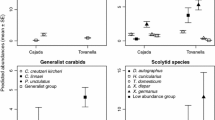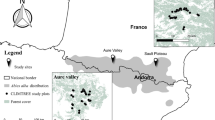Abstract
There are surprisingly few studies documenting effects of tropical cyclones (including hurricanes and typhoons) on rainforest animals, and especially insects, considering that many tropical forests are frequently affected by cyclonic disturbance. Consequently, we sampled a beetle assemblage inhabiting 18 upland rainforest sites in a fragmented landscape in north-eastern Queensland, Australia, using a standardised sampling protocol in 2002 and again 12 months after the passage of Severe Tropical Cyclone Larry (March 2006). The spatial configuration of sites allowed us to test if the effects of a cyclone and those from fragmentation interact. From all insect samples we extracted 12,568 beetles of 382 species from ten families. Beetle species composition was significantly different pre-and post-cyclone although the magnitude of faunal change was not large with 205 species, representing 96% of all individuals, present in both sampling events. Sites with the greatest changes to structure had the greatest changes in species composition. At the site level, increases in woody debris and wood-feeding beetle (Scolytinae) counts were significantly correlated but changes in the percent of ground vegetation were not mirrored by changes in the abundance of foliage-feeding beetles (Chrysomelidae). The overall direction of beetle assemblage change was consistent with increasing aridity, presumably caused by the loss of canopy cover. Sites with the greatest canopy loss had the strongest changes in the proportion of species previously identified in the pre-cyclone study as preferring arid or moist rainforest environments. The magnitude of fragmentation effects was virtually unaltered by the passage of Cyclone Larry. We postulate that in the short-term the effects of cyclonic disturbance and forest fragmentation both reduce the extent of moist, interior habitat.


Similar content being viewed by others
References
Anderson MJ (2004) PERMDISP: a FORTRAN computer program for permutational analysis of multivariate dispersions (for any two-factor ANOVA design) using permutation tests. In: Department of Statistics, University of Auckland
Anderson MJ (2005) PERMANOVA: a FORTRAN computer program for permutational multivariate analysis of variance. In: Department of Statistics, University of Auckland
Angulo-Sandoval P, Fernandez-Marin H, Zimmerman JK, Aide TM (2004) Changes in patterns of understory leaf phenology and herbivory following hurricane damage. Biotropica 36:60–67
Barberena-Arias MF, Aide TM (2002) Variation in species and trophic composition of insect communities in Puerto Rico. Biotropica 34:357–367
Bellingham PJ, Tanner EVJ, Rich PM, Goodland TCR (1996) Changes in light below the canopy of a Jamaican montane rainforest after a hurricane. J Trop Ecol 12:699–722
Bouget C, Duelli P (2004) The effects of windthrow on forest insect communities: a literature review. Biol Conserv 118:281–299
Brook BW, Sodhi NS, Bradshaw CJA (2008) Synergies among extinction drivers under global change. Trends Ecol Evol 23:453–460
Bruhl CA, Eltz T, Linsenmair KE (2003) Size does matter—effects of tropical rainforest fragmentation on the leaf litter ant community in Sabah, Malaysia. Biodivers Conserv 12:1371–1389
Bureau of Meteorology Australia (2009) Climate statistics for Australian locations. URL http://www.bom.gov.au/climate/averages/tables/ca_qld_names.shtml
Catterall C, Kanowski J, Wardell-Johnson G, Proctor H, Reis T, Harrison D, Tucker N (2004) Quantifying the biodiversity values of reforestation: perspectives, design issues and outcomes in Australian rainforest landscapes. In: Lunney D (ed) Conservation of Australia’s forest fauna, 2nd edn. Royal Zoological Society of New South Wales, Mosman, Australia, pp 359–393
Catterall CP, Mckenna S, Kanowski J, Piper SD (2008) Do cyclones and forest fragmentation have synergistic effects? A before-after study of rainforest structure at multiple sites. Austral Ecol 33:471–484
Daily GC, Ehrlich PR (1995) Preservation of biodiversity in small rain-forest patches—rapid evaluations using butterfly trapping. Biodivers Conserv 4:35–55
de Gouvenain RC, Silander JA (2003) Do tropical storm regimes influence the structure of tropical lowland rain forests? Biotropica 35:166–180
Didham RK, Lawton JH (1999) Edge structure determines the magnitude of changes in microclimate and vegetation structure in tropical forest fragments. Biotropica 31:17–30
Didham RK, Hammond PM, Lawton JH, Eggleton P, Stork NE (1998) Beetle species responses to tropical forest fragmentation. Ecol Monogr 68:295–323
Everham EM, Brokaw NVL (1996) Forest damage and recovery from catastrophic wind. Bot Rev 62:113–185
Ewers RM, Didham RK (2008) Pervasive impact of large-scale edge effects on a beetle community. Proc Natl Acad Sci USA 105:5426–5429
Freeman AND, Pias K, Vinson MF (2008) The impact of Tropical Cyclone Larry on bird communities in fragments of the endangered rainforest type 5b. Austral Ecol 33:532–540
Grimbacher PS, Catterall CP, Kitching RL (2006) Beetle species’ responses suggest that microclimate mediates fragmentation effects in tropical Australian rainforest. Austral Ecol 31:458–470
Grimbacher PS, Catterall CP, Stork NE (2008a) Do edge effects increase the susceptibility of rainforest fragments to structural damage resulting from a severe tropical cyclone? Austral Ecol 33:525–531
Grimbacher PS, Catterall CP, Kitching RL (2008b) Detecting the effects of environmental change above the species level with beetles in a fragmented tropical rain forest landscape. Ecol Entomol 33:66–79
Hansen MC, Stehman SV, Potapov PV, Loveland TR, Townshend JRG, DeFries RS, Pittman KW, Arunarwati B, Stolle F, Steininger MK, Carroll M, DiMiceli C (2008) Humid tropical forest clearing from 2000 to 2005 quantified by using multitemporal and multiresolution remotely sensed data. Proc Natl Acad Sci USA 105:9439–9444
Hoffmann AA, Hallas RJ, Dean JA, Schiffer DM (2003) Low potential for climatic stress adaptation in a rainforest Drosophila species. Science 301:100–102
Laurance WF, Curran TJ (2008) Impacts of wind disturbance on fragmented tropical forests: a review and synthesis. Austral Ecol 33:399–408
Laurance WF, Lovejoy TE, Vasconcelos HL, Bruna E, Didham RK, Stouffer PC, Gascon C, Bierregaard RO, Laurance SG, Sampaio E (2002) Ecosystem decay of Amazonian forest fragments: a 22-year investigation. Conserv Biol 16:605–618
Lawrence JF, Hastings AM, Dallwitz MJ, Paine TA, Zurcher EJ (2000) Beetles of the World. In: 1.0 edn. CSIRO, Collingwood, Victoria, Australia
Lugo AE (2008) Visible and invisible effects of hurricanes on forest ecosystems: an international review. Austral Ecol 33:368–398
Müller J, Bussler H, Gossner M, Rettelbach T, Duelli P (2008) The European spruce bark beetle Ips typographus in a national park: from pest to keystone species. Biodivers Conserv 17:2979–3001
Nichols E, Larsen T, Davis AL, Escobar F, Favila M, Vulinec K (2007) Global dung beetle response to tropical forest modification and fragmentation: a quantitative literature review and meta-analysis. Biol Conserv 137:1–19
Nix H (1991) Biogeography: pattern and process. In: Nix H, Switzer M (eds) Rainforest animals atlas of vertebrates endemic to Australia’s wet tropics. Australian National Parks and Wildlife Service, Canberra, pp 11–40
Ostertag R, Silver WL, Lugo AE (2005) Factors affecting mortality and resistance to damage following hurricanes in a rehabilitated subtropical moist forest. Biotropica 37:16–24
Plymouth Marine Laboratory (2002) Plymouth routines in multivariate ecological research. In: 5.2.9 edn. Primer-e, Plymouth, UK
Reagan DP (1991) The response of Anolis lizards to hurricane-induced habitat changes in a Puerto Rican rain forest. Biotropica 23:468–474
Schowalter TD, Ganio LM (1999) Invertebrate communities in a tropical rain forest canopy in Puerto Rico following Hurricane Hugo. Ecol Entomol 24:191–201
Shilton LA, Latch PJ, McKeown A, Pert P, Westcott DA (2008) Landscape-scale redistribution of a highly mobile threatened species, Pteropus conspicillatus (Chiroptera, Pteropodidae), in response to Tropical Cyclone Larry. Austral Ecol 33:549–561
Spiller DA, Schoener TW (2007) Alteration of island food-web dynamics following major disturbance by hurricanes. Ecology 88:37–41
SPSS (2007) Version 16.0. SPSS, Chicago
Stork NE, Grimbacher PS (2006) Beetle assemblages from an Australian tropical rainforest show that the canopy and the ground strata contribute equally to biodiversity. Proc R Soc B 273:1969–1975
Tanner EVJ, Kapos V, Healey JR (1991) Hurricane effects on forest ecosystems in the Caribbean. Biotropica 23:513–521
Torres JA (1992) Lepidoptera outbreaks in response to successional changes after the passage of hurricane Hugo in Puerto-Rico. J Trop Ecol 8:285–298
Tossas AG (2006) Effects of hurricane georges on the resident avifauna of Maricao State Forest, Puerto Rico. Caribb J Sci 42:81–87
Tracey J, Webb LJ (1975) Vegetation of the humid tropical region of north Queensland (15 maps at 1:100,000 scale + key). CSIRO Australia, Long Pocket labs, Indooroopilly, Queensland
Turton S (1992) Understorey light environments in a north-east Australian rain forest before and after a tropical cyclone. J Trop Ecol 8:241–252
Turton SM (2008) Landscape-scale impacts of Cyclone Larry on the forests of northeast Australia, including comparisons with previous cyclones impacting the region between 1858 and 2006. Austral Ecol 33:409–416
Turton SM, Siegenthaler DT (2004) Immediate impacts of a severe tropical cyclone on the microclimate of a tropical rainforest canopy in northeast Australia. J Trop Ecol 20:583–586
Van Bloem SJ, Murphy PG, Lugo AE, Ostertag R, Rivera Costa M, Ruiz Bernard I, Molina Colon S, Canals Mora M (2005) The influence of hurricane winds on Caribbean dry forest structure and nutrient pools. Biotropica 37:571–583
Walsh RPD (1996) Microclimate and hydrology. In: Richards PW (ed) The tropical rain forest an ecological study, 2nd edn. Cambridge University Press, Cambridge, pp 206–236
Wauer RH, Wunderle JM (1992) The effect of hurricane Hugo on bird populations on St-Croix, United-States Virgin-Islands. Wilson Bull 104:656–673
Webb LJ (1958) Cyclones as an ecological factor in tropical lowland rainforest, north Queensland. Aust J Bot 6:220–228
Webster PJ, Holland GJ, Curry JA, Chang HR (2005) Changes in tropical cyclone number, duration, and intensity in a warming environment. Science 309:1844–1846
Willig MR, Camilo GR (1991) The effect of hurricane Hugo on six invertebrate species in the luquillo experimental forest of Puerto-Rico. Biotropica 23:455–461
Winter JW, Bell FC, Pahl LI, Atherton RG (1987) Rainforest clearfelling in northeastern Australia. Proc R Soc Queensl 98:41–57
Wolda H (1992) Trends in abundance of tropical forest insects. Oecologia 89:47–52
Wunderle JM (1995) Responses of bird populations in a Puerto-rican forest to hurricane Hugo—the first 18 months. Condor 97:879–896
Wunderle JM, Mercado JE, Parresol B, Terranova E (2004) Spatial ecology of Puerto rican boas (Epicrates inornatus) in a hurricane impacted forest. Biotropica 36:555–571
Acknowledgments
We thank the Queensland Parks and Wildlife Service, and the many landowners (Coombers, Crawfords, Holdens, Littles, Stockers, Pam Taylor, and Margit Cianelli) for generously providing access to forest fragments. Carl Wardhaugh and Marios Aristophanous are thanked for their assistance in the field. Specimen preparation was assisted by Earthwatch volunteers, Annette Bryan, Danielle Lisle, Sue Stork, Michelle Larkman and Patricia Voigt. Comments from John Kanowski greatly improved the manuscript. We thank the JCU-CSIRO Tropical Landscapes Joint Venture and the Skyrail Rainforest Foundation for financial support.
Author information
Authors and Affiliations
Corresponding author
Additional information
Communicated by Roland Brandl.
Rights and permissions
About this article
Cite this article
Grimbacher, P.S., Stork, N.E. How do beetle assemblages respond to cyclonic disturbance of a fragmented tropical rainforest landscape?. Oecologia 161, 591–599 (2009). https://doi.org/10.1007/s00442-009-1399-5
Received:
Accepted:
Published:
Issue Date:
DOI: https://doi.org/10.1007/s00442-009-1399-5




